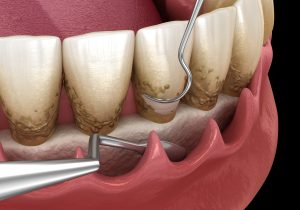What is Scaling and Root Planing?
Scaling and root planing, also known as dental deep cleaning, refers to two non-surgical procedures usually recommended for patients with mild to moderate gum disease, also known as gingivitis or periodontitis. Scaling involves the removal of plaque and tartar from the tooth surface, while root planing involves smoothing the root surfaces to remove bacteria and tartar. Dental deep cleaning can prevent further damage to the teeth and gums and can also reduce the risk of tooth loss.
Benefits of Scaling and Root Planing
Scaling and root planing has several benefits for patients who require gum disease treatment, including the following:
- Preventing Tooth Loss: Dental deep cleaning off the gums and teeth removes plaque and tartar buildup that can cause tooth decay and gum disease, helping prevent tooth loss.
- Reducing Inflammation and Infection: The deep cleaning of the gums and teeth that occurs during scaling and root planing can reduce inflammation and infection, which can improve overall oral health.
- Lowering Risk of Heart Disease and Stroke: Research has shown a link between gum disease and an increased risk of heart disease and stroke. By preventing or treating gum disease with dental deep cleaning, patients can also reduce their risk of these serious health conditions.
- Saving Money on Future Dental Costs: By preventing tooth loss and other serious oral health issues, dental deep cleaning treatment can help patients save money on future dental procedures and treatments.
The Scaling and Root Planing Process
Consultation
During your consultation with Dr. Nishime, he’ll evaluate your overall oral health and determine if dental deep cleaning is the best treatment for you. He’ll examine your gums and measure the depth of your gum pockets to assess the severity of your gum disease. He’ll also review your medical history and any medications that could affect your oral health.
Scaling
Once Dr. Nishime determines that scaling and root planing is the best treatment for you, he’ll begin with scaling. Scaling involves removing the plaque and tartar buildup from your teeth and below your gumline using special dental tools. This process can be done manually or with ultrasonic tools. Dr. Nishime may numb your gums with a local anesthetic to ensure your comfort throughout the process. He’ll then use the dental tools to scrape away the plaque and tartar, working carefully to avoid damaging your tooth enamel or gums.
Root Planing
After scaling is complete, Dr. Nishime will move on to root planing. Root planing involves smoothing the roots of your teeth to prevent further buildup of plaque and bacteria. This process removes bacterial toxins that cause gum disease and allows your gums to heal properly.
Dr. Nishime will use a special dental tool to smooth the rough surfaces of your tooth roots and remove any remaining plaque or bacteria. He’ll then flush out the gum pockets with water to remove all remaining debris.
Post-Treatment Care
After undergoing your deep cleaning treatment, patients need to take proper care of their teeth and gums to promote healing and prevent further damage. Here are some general aftercare instructions to follow:
- Avoid eating or drinking for at least one hour after the procedure to allow time for any numbing agents to wear off.
- Eat a soft diet for a few days after the procedure to avoid irritating the gums.
- Gently brush your teeth twice daily with a soft-bristled toothbrush and fluoride toothpaste to keep the teeth and gums clean.
- Floss daily to remove food particles or plaque buildup between the teeth.
- Rinse your mouth with a saltwater solution or mouthwash as recommended by your dentist to promote healing.
- Attend follow-up appointments with your dentist or periodontist as recommended to monitor the progress of your treatment and make any necessary adjustments.
Dr. Nishime will give you more specific instructions based on the unique details of your case. By following these aftercare instructions, you can help ensure the success of your deep cleaning treatment, improving and maintaining good oral health over the long term.
Frequently Asked Questions
The length of the procedure will depend on the severity of your gum disease and the number of teeth that need to be treated. Typically, scaling and root planing can take anywhere from one to two hours.
Your dentist will numb your gums with a local anesthetic before beginning the procedure, so you should not feel any pain during the treatment. However, you may experience some tenderness and discomfort after the procedure. Rest assured that this can be easily managed and usually subsides within a few days.
The frequency of scaling and root planing will depend on the severity of your gum disease. In most cases, patients with mild to moderate gum disease will need scaling and root planing every six months to a year. Patients with more advanced gum disease may need more frequent treatments.
Scaling and root planing can help treat and manage gum disease, but it can’t cure it. It’s important to maintain proper oral hygiene and schedule regular dental checkups to prevent further gum disease.
Call Dr. Nishime for Effective Scaling and Root Planing Treatment
If you’re experiencing gum disease symptoms, dental deep cleaning may be the best option for you. With years of experience and state-of-the-art technology, Dr. Nishime can help you restore the health of your gums so you can smile with more confidence and less pain.
Don’t wait until it’s too late — schedule your consultation by calling (808) 732-0291. You can also get in touch by filling out the contact form below, and one of our friendly team members will get back to you shortly. Dr. Nishime and the rest of our staff are proud to serve new and returning patients from Honolulu and surrounding areas such as Kailua, O‘ahu, and Kapolei, HI.



